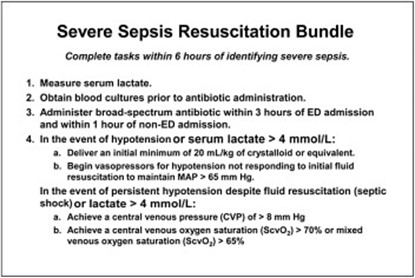A 29-year-old female patient is admitted to the emergency department with two of the systemic inflammatory response syndrome variables: temperature of 101.2 °F and 14,000 per μL white blood cell count. Which intervention from the sepsis resuscitation bundle does the nurse initiate?
Cooling baths
Broad-spectrum antibiotics
Blood transfusion
NPO status
The Correct Answer is B
The patient's symptoms of fever and elevated white blood cell count suggest a potential infection and sepsis. Broad-spectrum antibiotics should be initiated promptly to cover a wide range of possible pathogens until further diagnostic tests and identification of the specific causative agent are obtained. Early administration of appropriate antibiotics is crucial in sepsis management to target the suspected infection and improve patient outcomes.
A. Cooling baths in (option A) is incorrect because: Cooling baths are typically used in the management of hyperthermia or specific conditions like heatstroke. While the patient has an elevated temperature, it is likely due to the systemic inflammatory response rather than solely hyperthermia.
C. Blood transfusion in (option C) is incorrect because Blood transfusion may be required in certain cases of sepsis if there is evidence of significant anemia or active bleeding. However, based on the information provided, there is no immediate indication of a blood transfusion.
D. NPO status in (option D) is incorrect because NPO status (nothing by mouth) is a general precautionary measure used in various situations, such as prior to surgery or to manage gastrointestinal complications. It is not a specific intervention in the sepsis resuscitation bundle.
Therefore, the nurse should initiate the intervention of administering broad-spectrum antibiotics in this scenario.

Nursing Test Bank
Naxlex Comprehensive Predictor Exams
Related Questions
Correct Answer is B
Explanation
Positioning the transducer level with the phlebostatic axis is a crucial step in accurate hemodynamic monitoring. The phlebostatic axis is an imaginary reference point located at the fourth intercostal space, mid-anterior/posterior chest. Placing the transducer at this level ensures that the pressure measurements obtained are reflective of the patient's true hemodynamic status.
A. Positioning the limb with the catheter insertion site at the level of the transducer in (option A) is incorrect because: While it is important to position the limb appropriately to avoid kinks or occlusions in the catheter tubing, this is not directly related to the accurate measurement of hemodynamic parameters.
C. Ensuring that the patient is lying with the head of the bed flat for all readings in (option C) is incorrect because The position of the patient's head does not directly impact the accuracy of hemodynamic monitoring unless it specifically relates to changes in preload or intracranial pressure monitoring.
D. Balancing and calibrating the hemodynamic monitoring equipment every hour in (option D) is incorrect because: While it is important to ensure that the monitoring equipment is calibrated and functioning properly, doing so every hour may not be necessary. Calibration frequency may vary based on institutional policies and patient stability.
Therefore, the correct action that demonstrates effective teaching about hemodynamic monitoring is positioning the transducer level with the phlebostatic axis.
Correct Answer is B
Explanation
Shock is a state of inadequate tissue perfusion, resulting in compromised oxygen and nutrient delivery to cells and impaired cellular metabolism. Regardless of the specific cause or type of shock (e.g., hypovolemic, cardiogenic, distributive), the underlying problem is the failure to supply sufficient oxygen and nutrients to the body's tissues. This inadequate tissue perfusion can lead to cellular dysfunction, organ failure, and ultimately, life-threatening consequences.
A. Inefficient metabolism resulting from inadequate nutrition in (option A) is incorrect because While inadequate nutrition can contribute to the overall health status and resilience of an individual, it is not the central mechanism underlying all shock states.
C. Vasoconstriction and reflexive vasodilation due to circulating mediators in (option C) is incorrect because Vasoconstriction and vasodilation are physiological responses that can occur in various types of shock, but they are not the fundamental common denominator. Inadequate tissue perfusion remains the core issue.
D. Hypovolemia resulting from blood loss in (option D) is incorrect because Hypovolemia, which refers to decreased blood volume, is one potential cause of shock, specifically hypovolemic shock. However, other types of shock, such as cardiogenic or distributive shock, may not be primarily characterized by hypovolemia.
Therefore, the common denominator of all shock states is inadequate tissue perfusion, resulting in impaired cellular metabolism.
Whether you are a student looking to ace your exams or a practicing nurse seeking to enhance your expertise , our nursing education contents will empower you with the confidence and competence to make a difference in the lives of patients and become a respected leader in the healthcare field.
Visit Naxlex, invest in your future and unlock endless possibilities with our unparalleled nursing education contents today
Report Wrong Answer on the Current Question
Do you disagree with the answer? If yes, what is your expected answer? Explain.
Kindly be descriptive with the issue you are facing.
